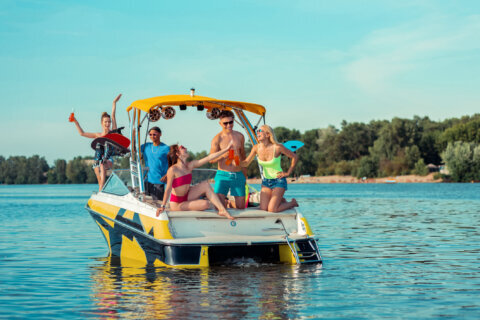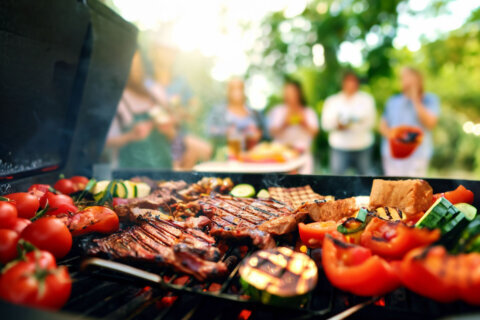The weather forecast couldn’t be more perfect for a long, summer weekend, and with weather this good, lots of people are going to be out on the water. Whether it’s the Chesapeake Bay, or any of the rivers or reservoirs in the D.C. area, safety becomes even more paramount on crowded waters, no matter how wide-open you think they are.
“You’re going to have boaters that have been boating for years out there, but remember, you’re going to have boaters that are brand new to boating as well,” said Donna Revelle, boating safety coordinator with Maryland’s Department of Natural Resources Police. “You have to keep your head on a swivel, make sure you’re looking around and seeing what the other people are doing.”
Whether you’re on a large boat, or paddling around in a kayak or canoe, one safety item she stressed was the need to wear a life jacket that fits.
“Whether you’re a swimmer or not, it’s different from being in a pool. That’s where most people learn how to swim,” Revelle said. “The sides of the pool are right there and easy to get to, but if you’re in the bay or in one of the tributaries, there’s tides, there’s waves, wakes, all kinds of things. And there’s murky water underneath it.”
As uncomfortable as it might be, she said you should wear a life jacket while you’re kayaking, even if you aren’t required to.
“We’ve already had a death in the last couple of weeks from a couple that was out on a canoe and it overturned, and they had one life jacket, and one of them panicked and couldn’t get back to shore,” she said. “Don’t think, ‘It can’t happen to me,’ because it can happen, and it does happen.”
There are different types of life jackets, depending on how old you are. If you have a child who is 4 years old or younger, she recommended a life jacket with a headrest that keeps their head over the water, as well as a strap that can make it easy for someone to pull the child out of the water.
Anyone under 13 on a boat that’s 21 feet long or less is required to have their life jacket on at all times. Make sure to try to lift the straps up from the shoulder — if the straps don’t go above the ears, it’s a good fit.
Additionally, make sure to have a flashlight, some sort of whistle or noise maker and double check the flares on board. Make sure they’re not expired, though if they are, use them first. Electric flares that blink an SOS are preferred.
“Other things that are required on a lot of boats now is something called an ECOS, which is your emergency cut off switch,” Revelle said. “You hook it to yourself and you plug it in to the ignition of your boat.”
Revelle said it’s especially important for boaters who are by themselves, because it pulls out the key and stops the boat if you fall overboard.
It’s also important to make sure all the boat’s lights are working and the gas tank is full.
“Make sure you know the rules of the road, who has the right of way,” she said. “Sailboats under sail have the right of way over power boats. A sailboat that does not have their sails up and is under power is the same as a power boat. Look out for jet skis, because they are all over the place. Jet Skis, just make sure they’re supposed to be 100 feet away from everything.”
In addition, Natural Resources Police is participating in Operation Dry Water from Friday through Sunday, part of a nationwide effort among police departments that patrol waterways aimed at cracking down on boating under the influence.
While boaters are allowed to drink a beer while steering a boat — something you can’t do while driving a car — the same .08 blood alcohol content limit is in effect, and being on the water means a beer or cocktail could hit you harder than a drink consumed on dry land.
“One drink on land is equal to three drinks on the water,” Revelle said. “It’s because the sun is beating down on you and you’re getting dehydrated.”
The movement of the boat also has an impact on alcohol’s effects, officials said.
“You’re constantly moving, and you kind of don’t take into account how much you’ve had to drink and how fast it can affect you,” said Officer Michael Brown, who is trained to spot people who operate a boat while under the influence of drugs or alcohol. “So while you are operating and trying to make your way back into dock or to do anything else, it may affect how you are able to operate.”
Brown said he knows the difference between safe and dangerous boating.
“Our thing is to make sure everybody makes it back home safely,” he said.
The driver of the boat and someone else on board should stay sober, officials said, in case the driver or other passengers need help.
“By 4 o’clock, 5 o’clock in the afternoon, your thought process is pretty much shot and your reaction time is shot. Your decision-making is shot,” Revelle said. “So stay sober while you’re boating. Let the other people on the boat enjoy a couple of drinks. But also, remember, you’re responsible for them.”
Get breaking news and daily headlines delivered to your email inbox by signing up here.
© 2025 WTOP. All Rights Reserved. This website is not intended for users located within the European Economic Area.







